
The Curtiss A-12 Shrike was the United States Army Air Corps' second monoplane ground-attack aircraft, and its main attack aircraft through most of the 1930s. It was based on the A-8, but had a radial engine instead of the A-8's inline, water-cooled engine, as well as other changes.

The Blohm & Voss BV 40 was a prototype armoured German glider initially designed in mid-1943 by Blohm & Voss to attack Allied bomber formations during World War II. The BV 40 would be towed to high altitude by other aircraft ahead of the bombers and then ram them while in a dive, but this concept was rejected before its first glide in May 1944. Development continued, although the glider's mission changed to attacking ships with very short-range torpedoes until it was cancelled in August with only six gliders completed.

The Henschel Hs 132 was a World War II dive bomber and interceptor aircraft of the German Luftwaffe that never saw service. The unorthodox design featured a top-mounted BMW 003 jet engine and the pilot in a prone position. The Soviet Army occupied the factory just as the Hs 132 V1 was nearing flight testing, the V2 and V3 being 80% and 75% completed.
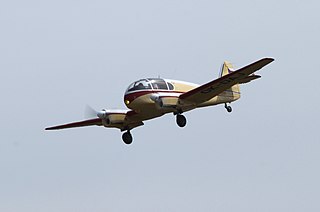
The Aero 45 was a twin-piston engined civil utility aircraft produced in Czechoslovakia after World War II. Aero Vodochody produced the aircraft in 1947–1951, after which the Let Kunovice rolled out these planes until 1961. In 1958 the Ae-45S became the first Czechoslovak plane to cross the Atlantic Ocean. It was the first product of the nation's postwar aviation industry and proved a great success, with many of the 590 produced being exported.

The Yokosuka R2Y Keiun was a prototype reconnaissance aircraft built in Japan late in World War II.

The Republic XP-72 was an American prototype fighter-interceptor developed by Republic Aircraft as a progression of the P-47 Thunderbolt design. The XP-72 was designed around the Pratt & Whitney R-4360 Wasp Major 28-cylinder air-cooled radial engine with a supercharger mounted behind the pilot and driven by an extension shaft from the engine. The armament consisted of six .50 caliber (12.7 mm) wing-mounted Browning AN/M2 machine guns and underwing racks for two 1,000 lb bombs; Alternative armament packages included two 37 mm M4 autocannons with four .50 caliber AN/M2s, or four M4 autocannons.

The Lippisch DM-1 was a single-seat research glider that was designed and built in Germany from 1944.
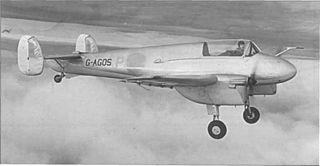
The Reid and Sigrist R.S.3 Desford is a British twin-engined, three-seat advanced trainer developed in the Second World War for postwar use. Although the R.S.3 was evaluated as a trainer, the type never entered production and was eventually rebuilt as the R.S.4 Bobsleigh as an experimental aircraft with the pilot in a prone position, seen as advantageous in minimising g-force effects in fighters.

The LVG C.II was a 1910s German two-seat reconnaissance biplane designed at the Luft-Verkehrs-Gesellschaft for the Luftstreitkräfte.
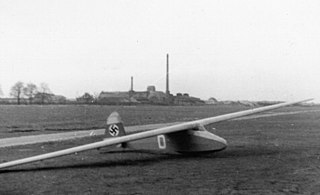
The Akaflieg München Mü13 Merlin and Akaflieg München Mü13 Atalante were gliders designed and built in Germany from 1935. A motor-glider version of the Merlin was converted by the addition of a small engine in the nose, as the Mü13M Motormerlin. Post-war development as the Mü13E entered production as the Scheibe Bergfalke.

The Mü-27 is a research glider aircraft that designed and built in Germany in 1979. Only one example was constructed.
The Akaflieg Stuttgart fs17 was a glider aircraft that was designed and built in Germany from 1936. It notably featured a prone seating position for its pilot.
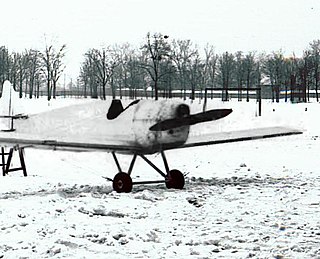
The Akaflieg München Mü8 is a light sports aircraft that was designed and built in Germany in 1933.
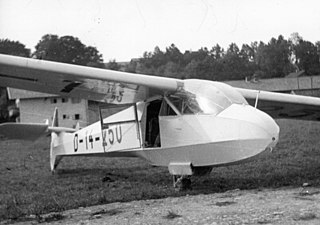
The Akaflieg München Mü15 was a two-seat glider designed and built in Germany in the late 1930s, loosely based on the Mü10. A longer span version, the Akaflieg München Mü20 was still in the design stages when further work was abandoned.

The Akaflieg Berlin B12 is a high performance two-place glider aircraft that was designed and built in Germany. Conceived as a research vehicle, only one unit was constructed.

The Akaflieg Berlin B13 is a two-seat motor-glider designed and built in Germany.
Akaflieg Darmstadt is one of approximately twenty aviation groups attached to German universities. Akaflieg is an abbreviation for Akademische Fliegergruppe, an academic group of students and faculty from a German University.

The Akaflieg Stuttgart fs26 Moseppl is a German single-seat motor glider with twin fins and rudders designed and built by Akaflieg Stuttgart. First flown on the 25 September 1970 it was designed as an experiment and not intended for production.

The Darmstadt D-29 was a German experimental monoplane designed and built by Akaflieg Darmstadt. The D-29 was a cantilever low-wing monoplane designed and built during 1936 with a conventional landing gear with a tailskid. It was powered by a Siemens-Halske Sh 14a radial piston engine and had enclosed tandem cockpits, as well as a number of other features, including hydraulically actuated trailing-edge flaps, a braced T-tail and leading-edge slots.

The Akaflieg Braunschweig SB-13 Arcus was an experimental tailless, single seat, Standard Class glider designed and built in Germany in the early 1990s. Though it performed as well as its conventional contemporaries, it did not offer sufficiently improved performance to compensate for its difficult handling characteristics.
This page is based on this
Wikipedia article Text is available under the
CC BY-SA 4.0 license; additional terms may apply.
Images, videos and audio are available under their respective licenses.


















